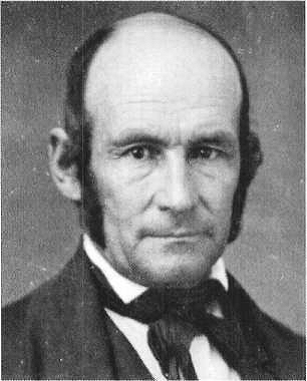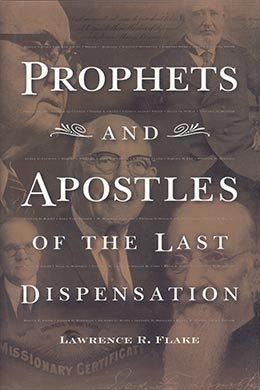Heber Chase Kimball
Lawrence R. Flake, Prophets and Apostles of the Last Dispensation (Provo, UT: Religious Studies Center, Brigham Young University, 2001), 169–72.

Born: 14 June 1801, Sheldon, Vermont
Quorum of the Twelve Apostles: 14 February 1835 (age 33)
First counselor to President Brigham Young: 27 December 1847
Died: 22 June 1868 (age 67), Salt Lake City, Utah
Heber C. Kimball was born in Sheldon, Vermont, in 1801. His father, a blacksmith and farmer, lost his land during the War of 1812. The family became very poor, and at age nineteen Heber was obliged to strike out on his own and found himself greatly wanting for the very necessities of life. His older brother, hearing of his desperate circumstances, invited him to learn the potter’s trade as his apprentice. Heber accepted his offer and with his brother moved to Mendon, New York. It was here that in 1827 Heber and his wife, Vilate Murray, witnessed one night a great vision in the heavens, which lasted for several hours. They beheld a large army marching on a highway in the sky and coming to blows with an opposing army. [1]
A few years later, missionaries came to Mendon to the home of Phineas Young, Brigham’s brother. Heber, a close friend of Brigham Young, heard the gospel and joined the Church. In 1832 he and Brigham traveled to Kirtland to visit the Prophet. Heber asked Joseph about the puzzling vision in the heavens, and the Prophet explained that it was symbolic of the final great struggle between the forces of good and evil brought about by the Restoration of the gospel. The Kimballs had beheld the vision on the very night that Joseph received the gold plates from the angel Moroni on the Hill Cumorah. Following this meeting with the Prophet Joseph Smith, Heber moved his family to Kirtland, Ohio. From there the Kimballs traveled with the Church to Missouri, Illinois, and eventually to the Salt Lake Valley. Brother Kimball was a member of the first company to arrive there on 24 July 1847. [2]
Ordained one of the original twelve apostles of this dispensation, Elder Kimball served numerous missions. The most remarkable of these was the first missionary journey of members of the Quorum of the Twelve to England, where during a period of eight months more than two thousand people were converted. During this period, Heber C. Kimball converted about one thousand five hundred people. [3] This mission was replete with marvelous manifestations—the casting out of devils, healing of the sick, speaking in tongues, and so forth. [4]
Brother Kimball possessed the gift of prophecy to a remarkable degree. In 1847 when the First Presidency was reorganized in Council Bluffs, Iowa, three years after the death of the Prophet Joseph Smith, Brigham Young chose Heber C. Kimball as his first counselor. A few years later, when Daniel H. Wells had been chosen as Brigham Young’s second counselor, President Young characterized these brethren: “Heber C. Kimball is my prophet and Daniel H. Wells is my statesman.” [5] A demonstration of Heber’s gift of prophecy occurred when Brother Kimball looked upon the splendid city of Nauvoo, where the people of Illinois seemed so willing to let the Saints settle, and said, “This is a beautiful place, but not long a resting place for the Saints.” [6] Sidney Rigdon, who held the common impression that their city would be permanent, was disturbed by this prophecy, but the sad fulfillment of Brother Kimball’s words came to pass.
Another time, when Parley P. Pratt was called on a mission to Canada, Heber made two prophecies—one that Parley’s wife, who had not been able during the ten years of their marriage to bear children, would have a son. The other prophecy was that Parley’s journey to Canada would be the beginning of a great missionary work in England. Both of these events came to pass: Sister Pratt had a baby boy and Elder Pratt converted John Taylor, whose labor as one of the first missionaries in England was a great success. Perhaps the most astounding prophecy was one that, after uttering it, Brother Kimball himself could scarcely believe. During the early days in the Salt Lake Valley, he predicted in an address before the nearly starving members of the Church that goods from the East would soon be available in the streets of Salt Lake at prices lower than in New York. This seemed incredible, but not long afterward gold was discovered in California. “Forty-niners,” anxious to reach the coast, flooded into the Salt Lake Valley and lightened their loads by trading their goods for next to nothing.
Brother Kimball spent all the energies of his later years building up the kingdom of God in the Salt Lake Valley. On 22 June 1868, at age sixty-seven, he died as the result of a severe fall. Bryant S. Hinckley, after comparing President Kimball’s gift of prophecy to that of the Prophet Joseph Smith, said, “He was one of the great men of his age, commanding in appearance, benevolent and fatherly toward the poor and the lowly, fearless and powerful in rebuking the wrongdoer. He was a leader of men.” [7]
Notes
[1] Orson F. Whitney, Life of Heber C. Kimball: An Apostle, the Father and Founder of the British Mission (Salt Lake City: Bookcraft, 1945), 15–17.
[2] Stanley B. Kimball, Heber C. Kimball: Mormon Patriarch and Pioneer (Urbana, 111.: University of Illinois Press, 1981), 169.
[3] Whitney, Life of Heber C. Kimball, 188–93.
[4] Whitney, Life of Heber C. Kimball, 124,129–31,165–66.
[5] Bryant S. Hinckley, The Faith of Our Pioneer Fathers (Salt Lake City: Deseret Book, 1956), 123.
[6] Matthias F. Cowley, Prophets and Patriarchs of the Church of Jesus Christ of Latter-day Saints (Chattanooga, TN: Ben E. Rich, 1902), 124.
[7] Hinckley, Faith of Our Pioneer Fathers, 123.
